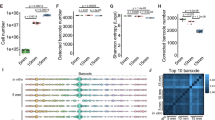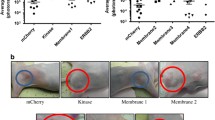Abstract
Understanding the genesis and development of tumors is an essential component in cancer research. It is of interest to discover unknown genes that are responsible for cellular transformation. A cDNA library of a highly metastatic lung adenocarcinoma cell line was constructed. This library was introduced into the NIH3T3 mouse embryonic fibroblast cell line to screen for cDNAs that increase anchorage-independent colony formation in soft agar. The expression of TSG101 in lung cancer cell lines and specimens was confirmed using reverse transcription-polymerase chain reaction. The level of TSG101 protein in transfected A549 cells was determined by western blotting. Cell-cycle distribution was analyzed using a FACStar Plus flow cytometer. One of the candidate cDNAs that increases anchorage-independent colony formation was shown to correspond to the TSG101 cDNA sequence. Levels of TSG101 mRNA were higher in lung cancer cell lines and specimens compared to matched normal lung tissues. Ectopic expression of TSG101 in the A549 lung adenocarcinoma cell line increased the numbers of cells in S phase, suggesting an increased cell proliferation rate. These results indicate that TSG101 may induce the malignant phenotype of cells.






Similar content being viewed by others
References
Li L, Cohen SN (1996) Tsg101: a novel tumor susceptibility gene isolated by controlled homozygous functional knockout of allelic loci in mammalian cells. Cell 85:319–329
Li L, Li X, Francke U, Cohen SN (1997) The TSG101 tumor susceptibility gene is located in chromosome 11 band p15 and is mutated in human breast cancer. Cell 88:143–154
Ali IU, Lidereau R, Theillet C, Callahan R (1987) Reduction to homozygosity of genes on chromosome 11 in human breast neoplasia. Science 238:185–188
Reeve AE, Sih SA, Raizis AM, Feinberg AP (1989) Loss of allelic heterozygosity at a second locus on chromosome 11 in sporadic Wilms’ tumor cells. Mol Cell Biol 9:1799–1803
Ruland J, Sirard C, Elia A, MacPherson D, Wakeham A, Li L, de la Pompa JL, Cohen SN, Mak TW (2001) p53 accumulation, defective cell proliferation, and early embryonic lethality in mice lacking tsg101. Proc Natl Acad Sci USA 98:1859–1864
Krempler A, Henry MD, Triplett AA, Wagner KU (2002) Targeted deletion of the Tsg101 gene results in cell cycle arrest at G1/S and p53-independent cell death. J Biol Chem 277:43216–43223
Wagner KU, Krempler A, Qi Y, Park K, Henry MD, Triplett AA, Riedlinger G, Rucker IE, Hennighausen L (2003) Tsg101 is essential for cell growth, proliferation, and cell survival of embryonic and adult tissues. Mol Cell Biol 23:150–162
Carstens MJ, Krempler A, Triplett AA, Van Lohuizen M, Wagner KU (2004) Cell cycle arrest and cell death are controlled by p53-dependent and p53-independent mechanisms in Tsg101-deficient cells. J Biol Chem 279:35984–35994
Liu RT, Huang CC, You HL, Chou FF, Hu CC, Chao FP, Chen CM, Cheng JT (2002) Overexpression of tumor susceptibility gene TSG101 in human papillary thyroid carcinomas. Oncogene 21:4830–4837
Young TW, Rosen DG, Mei FC, Li N, Liu J, Wang XF, Cheng X (2007) Up-regulation of tumor susceptibility gene 101 conveys poor prognosis through suppression of p21 expression in ovarian cancer. Clin Cancer Res 13:3848–3854
Oh KB, Stanton MJ, West WW, Todd GL, Wagner KU (2007) Tsg101 is upregulated in a subset of invasive human breast cancers and its targeted overexpression in transgenic mice reveals weak oncogenic properties for mammary cancer initiation. Oncogene 26:5950–5959
Koon N, Schneider-Stock R, Sarlomo-Rikala M, Lasota J, Smolkin M, Petroni G, Zaika A, Boltze C, Meyer F, Andersson L, Knuutila S, Miettinen M, El-Rifai W (2004) Molecular targets for tumour progression in gastrointestinal stromal tumours. Gut 53:235–240
Shen H, Pan Y, Han Z, Hong L, Liu N, Han S, Yao L, Xie H, Zhaxi C, Shi Y, Fan D (2004) Reversal of multidrug resistance of gastric cancer cells by downregulation of TSG101 with TSG101siRNA. Cancer Biol Ther 3:561–565
Zhu G, Gilchrist R, Borley N, Chng HW, Morgan M, Marshall JF, Camplejohn RS, Muir GH, Hart IR (2004) Reduction of TSG101 protein has a negative impact on tumor cell growth. Int J Cancer 109:541–547
Feng GH, Lih CJ, Cohen SN (2000) TSG101 protein steady-state level is regulated posttranslationally by an evolutionarily conserved COOH-terminal sequence. Cancer Res 60:1736–1741
Li L, Liao J, Ruland J, Mak TW, Cohen SN (2001) A TSG101/MDM2 regulatory loop modulates MDM2 degradation and MDM2/p53 feedback control. Proc Natl Acad Sci USA 98:1619–1624
Liu F, Li Y, Yu Y, Fu S, Li P (2007) Cloning of novel tumor metastasis-related genes from the highly metastatic human lung adenocarcinoma cell line Anip973. J Genet Genomics 34:189–195
Xia P, Gamble JR, Wang L, Pitson SM, Moretti PA, Wattenberg BW, D’Andrea RJ, Vadas MA (2000) An oncogenic role of sphingosine kinase. Curr Biol 10:1527–1530
Barr SM, Johnson EM (2001) Ras-induced colony formation and anchorage-independent growth inhibited by elevated expression of Puralpha in NIH3T3 cells. J Cell Biochem 81:621–638
Benard J, Ahomadegbe JC (1997) TSG101 and breast cancer: a correctly named tumor-suppressor gene? Bull Cancer 84:1141–1142
Zhong Q, Chen CF, Chen Y, Chen PL, Lee WH (1997) Identification of cellular TSG101 protein in multiple human breast cancer cell lines. Cancer Res 57:4225–4228
Wang Q, Driouch K, Courtois S, Champeme MH, Bieche I, Treilleux I, Briffod M, Rimokh R, Magaud JP, Curmi P, Lidereau R, Puisieux A (1998) Low frequency of TSG101/CC2 gene alterations in invasive human breast cancers. Oncogene 16:677–679
Sobel A (1991) Stathmin: a relay phosphoprotein for multiple signal transduction? Trends Biochem Sci 16:301–305
Maucuer A, Camonis JH, Sobel A (1995) Stathmin interaction with a putative kinase and coiled-coil-forming protein domains. Proc Natl Acad Sci USA 92:3100–3104
Watanabe M, Yanagi Y, Masuhiro Y, Yano T, Yoshikawa H, Yanagisawa J, Kato S (1998) A putative tumor suppressor, TSG101, acts as a transcriptional suppressor through its coiled-coil domain. Biochem Biophys Res Commun 245:900–905
Hittelman AB, Burakov D, Iniguez-Lluhi JA, Freedman LP, Garabedian MJ (1999) Differential regulation of glucocorticoid receptor transcriptional activation via AF-1-associated proteins. EMBO J 18:5380–5388
Gonzalez-Avila G, Biol JD, Martinez LM, Ramos C, Sommer B (2007) P53 and MDM2 isoforms in blood from lung cancer patients. Exp Lung Res 33:245–258
Berghmans T, Mascaux C, Haller A, Meert AP, Van Houtte P, Sculier JP (2008) EGFR, TTF-1 and Mdm2 expression in stage III non-small cell lung cancer: a positive association. Lung Cancer 62:35–44
Koonin EV, Abagyan RA (1997) TSG101 may be the prototype of a class of dominant negative ubiquitin regulators. Nat Genet 16:330–331
Ponting CP, Cai YD, Bork P (1997) The breast cancer gene product TSG101: a regulator of ubiquitination? J Mol Med 75:467–469
Szemraj J, Rozponczyk E, Bartkowiak J, Greger J, Oszajca K (2005) Significance of MDM2 protein in the cell cycle. Postepy Biochem 51:44–51
Cheng TH, Cohen SN (2007) Human MDM2 isoforms translated differentially on constitutive versus p53-regulated transcripts have distinct functions in the p53/MDM2 and TSG101/MDM2 feedback control loops. Mol Cell Biol 27:111–119
Young TW, Mei FC, Rosen DG, Yang G, Li N, Liu J, Cheng X (2007) Up-regulation of tumor susceptibility gene 101 protein in ovarian carcinomas revealed by proteomics analyses. Mol Cell Proteomics 6:294–304
Babst M, Odorizzi G, Estepa EJ, Emr SD (2000) Mammalian tumor susceptibility gene 101 (TSG101) and the yeast homologue, Vps23p, both function in late endosomal trafficking. Traffic 1:248–258
Bishop N, Woodman P (2001) TSG101/mammalian VPS23 and mammalian VPS28 interact directly and are recruited to VPS4-induced endosomes. J Biol Chem 276:11735–11742
Lu Q, Hope LW, Brasch M, Reinhard C, Cohen SN (2003) TSG101 interaction with HRS mediates endosomal trafficking and receptor down-regulation. Proc Natl Acad Sci USA 100:7626–7631
Amit I, Yakir L, Katz M, Zwang Y, Marmor MD, Citri A, Shtiegman K, Alroy I, Tuvia S, Reiss Y, Roubini E, Cohen M, Wides R, Bacharach E, Schubert U, Yarden Y (2004) Tal, a Tsg101-specific E3 ubiquitin ligase, regulates receptor endocytosis and retrovirus budding. Genes Dev 18:1737–1752
Rountree MR, Bachman KE, Baylin SB (2000) DNMT1 binds HDAC2 and a new co-repressor, DMAP1, to form a complex at replication foci. Nat Genet 25:269–277
Acknowledgments
This work is supported by the Education Agency Project (10553037) and the Health Agency Project (2005–20) of HeiLongJiang Province.
Author information
Authors and Affiliations
Corresponding author
Electronic supplementary material
Rights and permissions
About this article
Cite this article
Liu, F., Yu, Y., Jin, Y. et al. TSG101, identified by screening a cancer cDNA library and soft agar assay, promotes cell proliferation in human lung cancer. Mol Biol Rep 37, 2829–2838 (2010). https://doi.org/10.1007/s11033-009-9835-5
Received:
Accepted:
Published:
Issue Date:
DOI: https://doi.org/10.1007/s11033-009-9835-5




